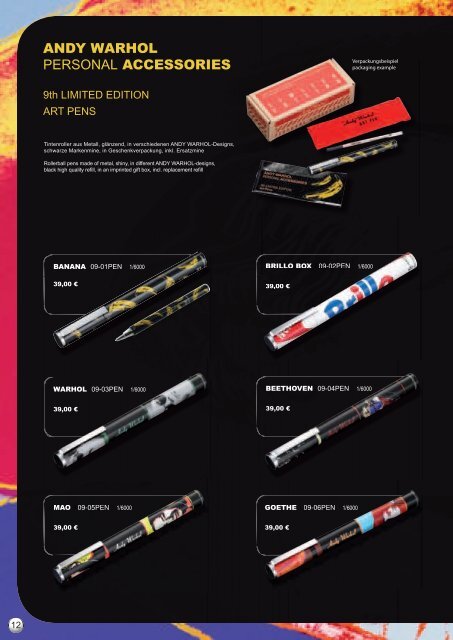personal accessories troika - Lime Internet
personal accessories troika - Lime Internet
personal accessories troika - Lime Internet
Create successful ePaper yourself
Turn your PDF publications into a flip-book with our unique Google optimized e-Paper software.
ANDY WARHOL<br />
PERSONAL ACCESSORIES<br />
9th LIMITED EDITION<br />
ART PENS<br />
Tintenroller aus Metall, glänzend, in verschiedenen ANDY WARHOL-Designs,<br />
schwarze Markenmine, in Geschenkverpackung, inkl. Ersatzmine<br />
Rollerball pens made of metal, shiny, in different ANDY WARHOL-designs,<br />
black high quality refi ll, in an imprinted gift box, incl. replacement refi ll<br />
BANANA 09-01PEN 1/6000<br />
39,00 €<br />
WARHOL 09-03PEN 1/6000<br />
39,00 €<br />
MAO 09-05PEN 1/6000<br />
39,00 €<br />
8<br />
BRILLO BOX 09-02PEN 1/6000<br />
39,00 €<br />
BEETHOVEN 09-04PEN 1/6000<br />
39,00 €<br />
GOETHE 09-06PEN 1/6000<br />
39,00 €<br />
Verpackungsbeispiel<br />
packaging example<br />
ORIGINAL ARTWORKS<br />
Banana, 1966<br />
Screenprint on styrene, 24 x 53 ¼ inches<br />
1966 entwarf und produzierte Warhol das erste Album von The Velvet<br />
Underground and Nico. Das Debütalbum der Velvets und das bekannte<br />
Bild “Banana”, mit Warhols gestempelter Unterschrift auf dem<br />
Album Cover, ist eines der anerkanntesten und geschätztesten Alben<br />
in der Geschichte des Rock and Roll.<br />
In 1966, Warhol produced and designed the fi rst album of The Velvet<br />
Underground and Nico. The Velvet’s debut album with the famous<br />
Banana image with Warhol’s stamped signature is one of the most<br />
recognized and revered albums in rock and roll history.<br />
Andy Warhol Self-Portrait, c. 1963<br />
Photobooth Picture<br />
Sein Leben lang hat Andy Warhol ständig neu defi niert, wer er war,<br />
sowohl als Künstler als auch als Symbol in der Öffentlichkeit. Von<br />
den 1960ern bis in die 1980er stellte er sich selbst bildlich als Gegenstand<br />
seiner Kunst dar, ob in seinen Fotokabinen-Selbstporträts<br />
in den frühen 1960ern, seiner TV Sendung auf MTV namens “Andy<br />
Warhol’s Fifteen Minutes” in den frühen 1980ern, oder seine letzte<br />
Serie von Selbstporträts 1986 bekannt als “fright wig” Selbstporträt.<br />
Warhol verstand, dass sein Erbe und sein öffentliches Image so<br />
wertvoll waren, wie die Siebdrucke die er schuf. Heute inspiriert und<br />
belebt Warhol Kulturen weltweit und sein persönliches Image ist so<br />
kultig und erkennbar wie zu seinen Lebzeiten.<br />
Throughout his lifetime, Andy Warhol continually reinvented who he<br />
was, both as an artist and icon to the public. In the 1960s through the<br />
1980's, Warhol depicted himself as the subject matter of his artwork<br />
whether it was in his photobooth self-portraits of the early 1960s, his<br />
television show in the early 1980s on MTV called “Andy Warhol’s<br />
Fifteen Minutes”, or his fi nal series of self-portraits in 1986 known as<br />
the “fright wig” self-portraits, Warhol understood that his legacy and<br />
public image were as valuable as the silk screen artworks he created.<br />
Today, Warhol continues to inspire and excite cultures around the<br />
world, and his <strong>personal</strong> image is as iconic and recognizable now as<br />
it was during his lifetime.<br />
Mao, 1972<br />
Screenprint on white paper<br />
36 x 36 inches<br />
1972 veröffentlichte Warhol „Mao“, ein Portfolio, bestehend aus zehn<br />
Siebdrucken. Das Motiv Mao entspricht dem Bild vom Deckel des<br />
Buches ‚Zitate des Vorsitzenden Mao Tse-Tung‘ und wurde im Jahr<br />
der Chinareise Richard Nixons ausgewählt - eine Periode in der die<br />
Person Mao die amerikanische Öffentlichkeit faszinierte und folglich<br />
Interesse bei Warhol weckte.<br />
In 1972, Warhol published 'Mao', a portfolio of ten screenprints. The<br />
image of Mao was taken from the cover of Quotations from Chairman<br />
Mao Tse-Tung, and was chosen during the year of Richard Nixon‘s<br />
trip to China - a time when Mao became a subject of fascination for<br />
the American public, and as a result, a subject of interest to Warhol.<br />
Brillo Soap Pads Box, 1964<br />
Silkscreen ink and house paint on plywood<br />
17 x 17 x 14 inches<br />
Im März und April 1964 veränderte Andy Warhol die Kunstgeschichte<br />
für immer, als er einhundert Brillo Soap Pads Kisten für eine Ausstellung<br />
seiner Kisten-Skulpturen in der Stable Gallery in New York<br />
herstellte. Kritiker behaupteten, dass die Brillo Box Skulpturen von<br />
Warhol dem bestehenden Lebenszyklus der westlichen Kunst ein<br />
Ende setzten und zu einem Pluralismus führten, der die Art und Weise,<br />
wie Kunst erstellt, wahrgenommen und ausgestellt wird, verändert<br />
hat. Die Kisten-Skulpturen von Warhol gingen weit über das einfache<br />
Abbilden von Handelsprodukten hinaus - zur Neuschaffung der<br />
Handelsprodukte als Kunst.<br />
In March and April of 1964, Andy Warhol changed art history forever<br />
when he produced one hundred Brillo Soap Pads boxes for an<br />
exhibition of his box sculptures at the Stable Gallery in New York.<br />
Critics have argued that Warhol‘s Brillo Box sculptures brought the established<br />
trajectory of Western art to an end, and gave rise to a pluralism<br />
that has changed the way art is made, perceived and exhibited.<br />
Warhol’s box sculptures went beyond simply reproducing commercial<br />
images to recreating commercial objects themselves as fi ne art.<br />
Beethoven, 1987<br />
Screenprint on Lenox Museum Board<br />
40 x 40 inches<br />
Warhols Beethoven (1987) beruht auf Karl Josef Stielers Gemälde<br />
‚Beethoven‘ aus dem Jahr 1819, ausgestellt im Beethoven-Haus in<br />
Bonn, Deutschland. Die abgebildeten Noten sind aus Beethovens<br />
Mondschein Sonate, Opus 27, Nummer 2, aus dem Jahr 1801.<br />
Warhol‘s Beethoven (1987) is based on Karl Josef Stieler’s 1819<br />
painting Beethoven, in the Beethoven-Haus in Bonn, Germany. The<br />
musical notes are from Beethoven’s 1801 Moonlight Sonata, Opus<br />
27, no.2.<br />
Goethe, 1982<br />
Screenprint on Lenox Museum Board<br />
38 x 38 inches<br />
TM Campbell Soup Company. All rights reserved.<br />
Warhol erstellte einige Drucke, bei denen er sich von historischen<br />
Kunstwerken inspirieren ließ. ‚Goethe‘ (1982) ist dem Gemälde<br />
‚Goethe in der Römischen Campagna‘ 1787-88 von Johann Wilhelm<br />
Tischbein nachempfunden, das im Städelschen Kunstinstitut und der<br />
Städtischen Galerie in Frankfurt, Deutschland, ausgestellt wird.<br />
Warhol created a number of prints inspired by historical works of art.<br />
Goethe is based on Johann Wilhelm Tischbein’s 1787-88 painting<br />
‘Goethe in der Römischen Campagna‘, in the ‘Stadelsches Kunstinstitut<br />
und Städtische Galerie‘ in Frankfurt, Germany.<br />
12 13



